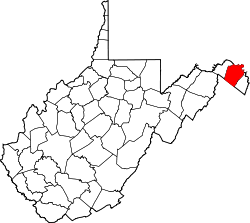Falling Waters, West Virginia | |
|---|---|
 Location in Berkeley County and the state of West Virginia. | |
| Coordinates: 39°33′54″N77°52′47″W / 39.56500°N 77.87972°W | |
| Country | United States |
| State | West Virginia |
| County | Berkeley |
| Area | |
• Total | 1.245 sq mi (3.22 km2) |
| • Land | 1.245 sq mi (3.22 km2) |
| • Water | 0 sq mi (0 km2) |
| Elevation | 443 ft (135 m) |
| Population (2020) | |
• Total | 1,440 |
| • Density | 1,160/sq mi (447/km2) |
| Time zone | UTC−5 (Eastern (EST)) |
| • Summer (DST) | UTC−4 (EDT) |
| ZIP Code | 25419 |
| Area code | 304 |
| GNIS feature ID | 2586801 [2] |
Falling Waters is a census-designated place (CDP) on the Potomac River in Berkeley County, West Virginia, United States. It is located along Williamsport Pike (US 11) north of Martinsburg. An 1887 Scientific American article claimed that the first U.S. railroad was built in Falling Waters in 1814. [3] The population was 1,440 at the 2020 census. [4]

